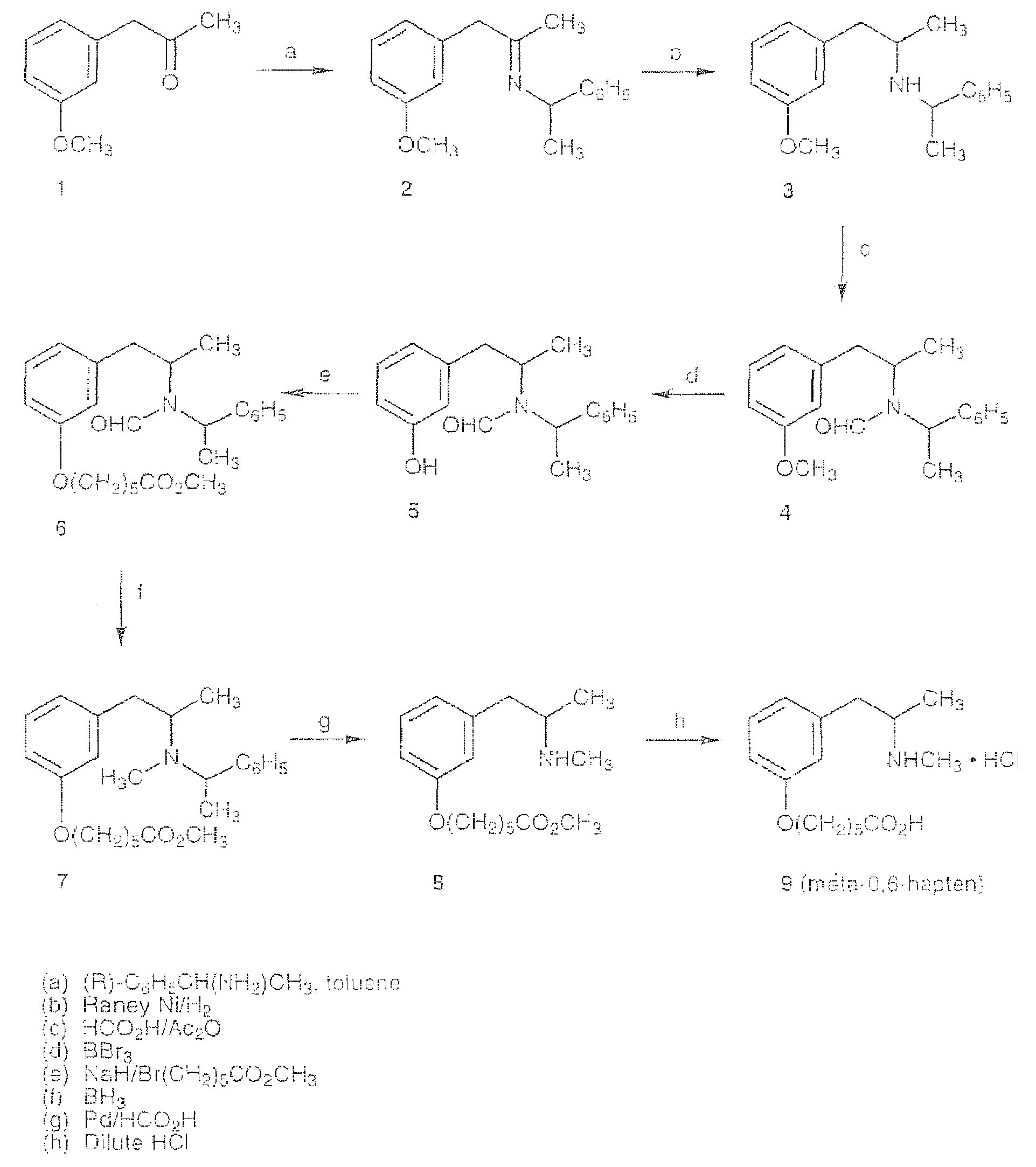Methamphetamine-like hapten compounds, linkers, carriers and compositions and uses thereof
a technology of hapten compounds and methamphetamine, which is applied in the field of hapten compounds, can solve the problems of hyperactivity, paranoia, and agitation, and the development of medical treatments for alleviating the adverse psychosocial and health effects of d-methamphetamine and similar stimulants is badly needed, and the development of medical strategies for treating the complex array of neurological problems associated with drug abuse has been frustratingly slow. , to achieve the effect of increasing meth concentration
- Summary
- Abstract
- Description
- Claims
- Application Information
AI Technical Summary
Problems solved by technology
Method used
Image
Examples
example 1
Protocol for Generation of High Affinity Monoclonal Antibodies and Fab Fragments that Bind to D-Methamphetamine and Other Stimulant Drugs
[0202]The haptens are coupled to a bovine serum albumin antigen by using a general synthesis procedure (Minh-Tam et al., 1981). This two-step, modified carbodiimide procedure permits a defined number of haptens to be covalently bound to the protein in a controlled molecular orientation. It also minimizes cross linking of protein molecules and the unwanted conjugation of the haptens through the free amino group on the d-methamphetamine haptens. A complimentary ovalbumin-d-methamphetamine hapten was also generated for use in screening hybridoma products in an enzyme-linked immunosorbent assay (ELISA). This general synthesis procedure has been used in the past to generate anti-drug antibodies (Owens et al., 1988) and anti-peptide antibodies (Laurenzana et al., 1995).
[0203]For the production of monoclonal antibodies, BALB / c mice (n=6-10 per hapten) are...
example 2
Protocol for the Synthesis Of Hapten Compounds
[0207]The methamphetamine-like stimulants that are most often abused are methamphetamine, amphetamine and MDMA (FIG. 3). Based on review of the literature on anti-methamphetamine antibodies (e.g., Faraj et al., 1976; Usagawa et al., 1989; Ward et al., 1994) and analysis of the molecular features of the molecules shown in FIG. 3, it is hypothesized that coupling of a spacer group (with a carboxylic acid terminus) at the para or meta position of the aromatic ring structure will offer the best chance for generating a class-specific antibody. The resulting antibodies are expected to react best with the parent compound, as opposed to metabolites, and would also be less likely to significantly cross react with natural neurotransmitters. If the protein was coupled to the amine groups at the other end of the molecule (which would be more convenient), this would not generate antibodies that would cross react with MDMA. The haptens designed for ge...
example 3
Synthesis of the intermediate compound (R,R)—N-α-Methylbenzyl-3-Methoxyamphetamine Hydrochloride
[0211]A solution of 3-methoxyphenylacetone (10 g, 0.061 mol) and (R)-α-methylbenzylamine (7.38 g, 0.061 mol) in 100 mL of dry toluene was heated to reflux in a flask fitted with a Dean-Stark condenser for 20 h. After cooling the reaction mixture, the solvent was removed, and the residue was dried under vacuum. The residual oil was dissolved in absolute EtOH (60 mL), and a slurry of EtOH washed Raney nickel was added. The resulting mixture was hydrogenated for 96 h at 40 psi hydrogen. The catalyst was removed by filtration over a Celite bed, and the filtrate was treated with HCl gas. Evaporation of the solvent gave a white solid which was triturated with hot acetone to provide the target compound 3 of FIG. 6 as a white solid. An analytical sample was prepared from an aliquot removed. The sample recrystallized from MeOH / diethyl ether had mp 215-218° C.; [a]21D (17.85°, c 1.95, MeOH). 1H NMR...
PUM
| Property | Measurement | Unit |
|---|---|---|
| time | aaaaa | aaaaa |
| pH | aaaaa | aaaaa |
| pH | aaaaa | aaaaa |
Abstract
Description
Claims
Application Information
 Login to View More
Login to View More - R&D
- Intellectual Property
- Life Sciences
- Materials
- Tech Scout
- Unparalleled Data Quality
- Higher Quality Content
- 60% Fewer Hallucinations
Browse by: Latest US Patents, China's latest patents, Technical Efficacy Thesaurus, Application Domain, Technology Topic, Popular Technical Reports.
© 2025 PatSnap. All rights reserved.Legal|Privacy policy|Modern Slavery Act Transparency Statement|Sitemap|About US| Contact US: help@patsnap.com



